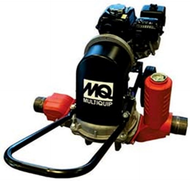Ask anyone in the fluid transfer industry, and they’ll all tell you the same thing: using innovative and leading-edge tools can really make a difference.
When it comes to fluid transfer, handling fluids through membrane pumps or diaphragm pumps has become quite popular. This tool was crafted to have a flexible structure that allows easy fluid movement and helps to save time, providing maximized efficiency.
So, if you’ve been looking to learn more about diaphragm pumps, you’re at the right place! Read on to learn how diaphragm pumps are transforming fluid transfer procedures and can help you streamline processes.
Let’s begin!
A Closer Look at Diaphragm Pumps – Understanding The Basics

The diaphragm pump, also known as the Air Operated Double Diaphragm (AODD), is a positive displacement pump that is used to move fluids using compressed air.
This membrane pump consists of a pneumatic valve that allows the back-and-forth movement of compressed air between the two pump sides.
These meticulously designed pumps can handle fluids with suspended solids and of various viscosity levels. This is why it is used to efficiently handle aggressive chemicals and large amounts of fluids and transfer them from one place to another.
Unlike traditional pumps, diaphragm pumps utilize a flexible diaphragm to move fluid. This diaphragm, often made of materials like rubber or thermoplastics, undergoes repetitive flexing to create a pulsating flow. This design offers a myriad of advantages over conventional pump designs.
Firstly, the pulsating movement reduces shear forces, making diaphragm pumps ideal for handling shear-sensitive fluids such as polymers and fragile biological materials. This gentle fluid transfer is crucial in industries like pharmaceuticals and biotechnology, where maintaining the integrity of the product is super important.
Secondly, the positive displacement nature of diaphragm pumps ensures a consistent and precise flow rate. This is particularly advantageous in applications where accurate dosing is essential, such as chemical processing or water treatment. The ability to control flow with precision contributes to increased process efficiency and reduced waste.
Technicians typically use three types of diaphragm pumps:
Those with a flexed diaphragm and a sealed pump. These pumps can efficiently increase and decrease the chamber volume and prevent the fluid from reversing.
Those that use one or multiple unsealed sections where the fluid can be pumped to both sides. They also have a flexed diaphragm, which can cause the volume to change.
Those that use volumetric positive displacement. The diaphragm in these pumps moves by an electro-mechanical action where the user has to use a handle or a lever to move it.
The Main Components of a Diaphragm Pump

Some of the main components of the diaphragm pump include:
The Central Body: The central body of the diaphragm pump consists of an inlet and an outlet for air supply. This part of the pump also includes a pneumatic exchanger that provides pressure to the air valve. This pressure is required to move the membranes.
The Diaphragm: This part of the pump is built with a variety of materials and serves as a barrier for the fluids.
The Fluid Chambers: The fluid chambers house the fluids that are supposed to be drawn and pumped. This chamber has two membranes.
The Air Valve: The air valve passes on compressed air that contributes to the membrane movement. The diaphragm also separates the fluid pump side from the air side.
What Makes Diaphragm Pumps the Top Choice For Fluid Transfer Procedures?

Their incredible versatility. Diaphragm pumps can handle a wide range of fluids, from thin to clean and to viscous and abrasive.
This versatility makes them suitable for a wide range of industries, like oil and gas, agriculture, food and beverage, etc.
These pumps are commonly employed in industries where pumping abrasive slurries is a common requirement. The robust design of the diaphragm allows for the efficient transfer of such materials without the risk of pump damage or degradation of performance.
Furthermore, diaphragm pumps are self-priming, meaning they can draw fluid from a suction source without the need for external priming. This self-priming capability simplifies installation and operation, making diaphragm pumps a popular option for applications where ease of use is a priority.
They can be used in:
- General unloading and transferring
- Filter press
- Paint filtration
- Mixing tanks
- Powder coating
- Air spray
- Pigment milling
- Filling machines
- They can also be used for a myriad of fluids:
- Greases
- Paints
- Lacquers
- Adhesives
- Latex
- Varnishes
- Corrosive chemicals
- Shear-sensitive pharma products
- Volatile solvents
- Sticky fluids
- Creams and gels
- Oils
- Abrasive slurry
- Dirty water
Safe and Reliable
Safety is a top priority in any industrial setting, and diaphragm pumps excel in this regard. The hermetic separation of the pumped fluid from the drive components eliminates the risk of leakage and contamination. This not only safeguards the product being transferred but also prevents harm to personnel and the environment.
Additionally, diaphragm pumps are known for their reliability. The absence of dynamic seals, which are prone to wear and failure in other pump types, contributes to the longevity of diaphragm pumps. The robust construction of the diaphragm itself, along with the simple design of the pump, minimizes the need for frequent maintenance and ensures a longer operational lifespan.
Buy High-Quality Diaphragm Pumps at TMS Equip!
All in all, diaphragm pumps have emerged as a game-changer when it comes to fluid transfer procedures.
Their innovative design, unparalleled versatility, and inherent safety features make them a popular choice in an array of industries. Whether it's handling abrasive materials, maintaining the integrity of sensitive fluids, or ensuring precise dosing, diaphragm pumps have proven their worth.
As technology continues to advance, diaphragm pumps will likely see further refinements and applications. Their role in revolutionizing fluid transfer is not just a trend but a testament to the enduring impact of smart engineering on industrial processes.
Ready to invest in high-quality diaphragm pumps to increase your work efficiency and operational efficacy?
Check out the collection of tools and equipment at TMS Equip!
We offer the most carefully crafted power tools and core bits, including mortar mixers, portable cement mixers,multi-quip trash pumps,field-stone cutting blades, plate compactors, and more.
Visit our online store and drop us a message to place your place orders now.


